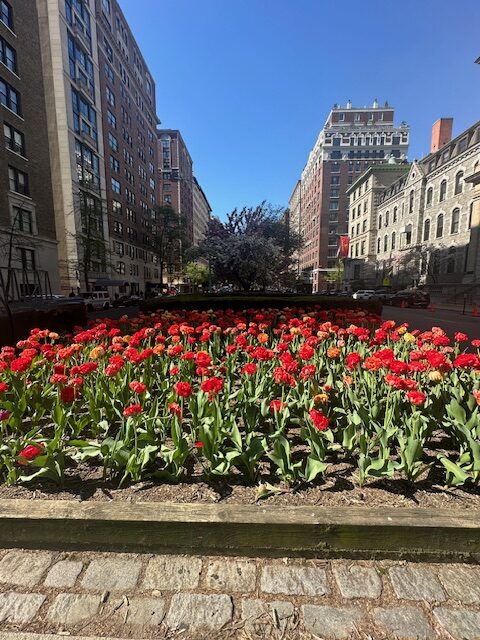Dutch Orange Balloon and Peony-Flowering Tulips
The Statue of Liberty, Central Park, the High Line, and the Park Avenue Malls. What do these New York icons have in common? All four faced an uphill battle before becoming an indelible part of the city. And those battles took vision, persistence, serendipity, philanthropy, and luck.
This year the Park Avenue Malls were tightly planted with Dutch orange Balloon and Peony Dutch hybrid blossoms, chosen tulips to help commemorate the 400th anniversary of the first ship bearing Dutch settlers to New Amsterdam.

Ammirael vander Schellink Courtesy of Arader Galleries
Tulips faced a long journey to the Malls. In the 16th century, Ottoman Empire Sultans favored tulips over all other flowers in their lush gardens. The more exotic the variety the better. As with music, dress, and art, the sultans’ aristocratic retinue sought to emulate the taste of their sovereigns. The tulip became a status symbol, often referred to as the “Power Flower.” The striped varieties were valued above all others. This was an early iteration of Tulip Mania.
Eminent 16th Century Dutch botanist Carolus Clusius helped introduce tulips to The Netherlands. Serendipitously, the soil just behind the Dutch dunes contained the perfect medium for growing tubers: clay, sand, and loam. Later Dutch entrepreneurs, adept at turning spices into commodities, created a worldwide market for tulips and other tubers.
Vision and Persistence

Early 20th Century Park Avenue was not the posh quarter we know today. North-south steam trains plied its middle, often killing pedestrians. Once trains switched to electric power, the “monsters” could be buried underground. Left was a scraggy scar of a thoroughfare.
Philanthropist and socialite Mary Lasker set out to change the view. She was determined to show that flowers and trees could flourish despite pollution, the heat generated by the underground trains, and the lack of an irrigation system. On her own in the 1950s she took on the then benighted avenue, planting begonias, tulips, and flowering trees in the poor soil that covered the train tunnels. To find a bulb tough enough for Park Avenue, she consulted Long Island bulb importer Peter Van de Wetering. It had to be a Darwin hybrid, came the answer, the only bulbs tough enough for big city challenges. Darwin hybrids are used to this day and still supplied by the vast Van De Wetering family’s Jamesport, Long Island greenhouses planting Fund’s flower beds from 64th to 86th Streets of the Malls. Anthony Bulfamante & Son of New Rochelle, NY, supply the northern blocks, 86th to 96th Streets, managed by Carnegie Hill Neighbors.
Philanthropy
Lasker insisted that philanthropy, not public funding, should finance the Malls. At the time, the wealthy of New York considered funding public amenities a waste of money better spent on art.
Formal work on the malls began in 1970. In the 80s, with New York near bankruptcy, the city’s public parks were in dire straits. The Malls were no exception. Mary Lasker returned to help, this time assisted by two non-profit groups, Carnegie Hill Neighbors and the Fund for Park Avenue.
Today, neither visitors nor residents can imagine Park Avenue without its lush plantings. And it is the tulips that draw the most attention and inspire the most affection from New Yorkers and visitors alike.
In mid-May comes yet another version of Tulip Mania when hundreds of gardeners descend on Park Avenue with shovels and trowels to dig up the bulbs once their leaves have turned yellow. The almost almost 90,,000 bulbs then find their way to gardens throughout the state and the region.





